Within the vast category of canoes we can make a first major distinction between canoes proper (Canadian, Polynesian, etc.), in which you paddle in a kneeling or sitting position with a simple paddle, that is, equipped with a single blade and a T-handle on the opposite side of the handle, and the kayaks in which you paddle, still seated, with a double paddle, i.e. with two blades at opposite ends of the handle. Both the canoes and the kayaks can then be closed, that is, equipped with a deck with an opening called the cockpit, of more or less large dimensions, in which the paddler "enters" to lead the vehicle (with the possibility or not of sealing the opening with a splash guard) or open, i.e. not fitted with a deck.
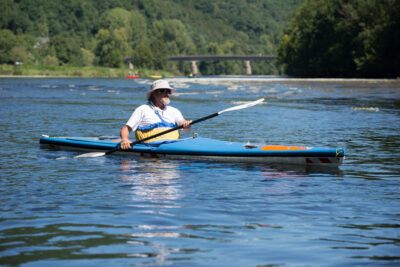
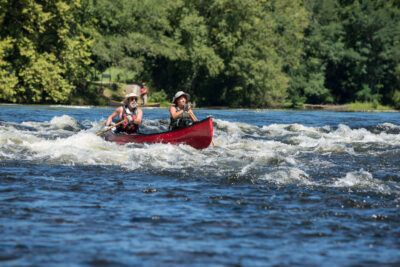
The closed or decked Canadian canoes are used almost exclusively in the competitive field, and therefore we will not deal with them here. The same goes for Polynesian canoes equipped with a balance floater. Instead, we will deal with Canadian open canoes which represent one of the most versatile means for river or lake tourism. Not marine! Why? Because they are not equipped with a keel and offer more resistance to the wind than kayaks are not suitable for marine use.
They were one of the main means of exploration of the North American continent and still today they are an extremely versatile means. They are especially popular in two-seater or multi-seater versions, for family use, but there are also single-seater models. The advantages of these boats are versatility, the ability to load a lot of material, or excursion companions, ideal for those who want to take their dog, camping equipment, etc. on a trip ... The large open space allows you to move (with care) change position, sunbathe, stop for a snack without having to disembark etc ... with practice they can also be led standing up, like a SUP. By making them unsinkable by means of special air-filled balloons, they can also be used in rapids, but it is already a more specialized use. At the level of beginners, they find their most suitable environment in the quiet rivers of the valley floor or in the lakes, they are perfect for family use, both for short and multi-day trips, as they allow you to take everything you need with you. On the other hand, they require a slightly longer apprenticeship to learn how to steer them, especially for the paddler sitting in the back, who must also take care of steering. However, an experienced paddler can easily bring a complete neophyte. As we have said, they suffer more from the wind, due to the height of the freeboard (lower edges will be less sensitive to the wind but will take on more water in the event of waves). On average, with the same length and profile, they are a bit slower than kayaks, also due to the greater width. They are very suitable for families, camping, fishing, nature photography, etc ...

Kayaks have a lower profile on the water so they are less affected by the wind, they can be easier to steer (a lot depends on the model and profile, see the first article), they are faster on average. Some are equipped with rudder or appendages that make direction control even easier. The basic technique is a little easier to acquire. On the other hand, they have a much lower load capacity, apart from rare exceptions it is not possible to carry animals or passengers, it is not possible (or very little) to change position and move inside the hull.
They are generally single-seater, more rarely two-seater.
There are specific models perfect for marine use.
As you can see also in this case, as written in the first article, it is essential to know first what the main use will be: if for example I want to do marine touring I will have to orient myself on kayaking, if instead I want to go hiking on the lake with family or dog it will be more appropriate to choose a Canadian.
Also for the materials, both in the case of canoes and kayaks, what is written in the previous article applies.
When, for good reason, the choice falls on a kayak, then the hamletic doubt must be resolved: sit in or sit on? Sit in are the classic kayaks with cockpit, in which you "enter" and you can seal the opening with the spraydeck. Sit on top are kayaks in which the cockpit is replaced by a more or less anatomical, open footprint on which you sit. Let's see advantages and disadvantages of both.
A sit-in kayak is warmer and drier, it is better controlled with the knees allowing you to make more use of the inclination, learning the maneuver of the eskimo (the technique to straighten the hull without abandoning it) becomes very safe and allows you to face very rough waters, it can be equipped with watertight behaviors in which to store the material (called lockers). On the other hand, novices may feel insecurity linked to the fact of having to "slip" from the cockpit in case of overturning, if you are forced to get out of the hull it is more difficult (but not impossible) to get back from the water, without reaching the shore.
A sit on top kayak allows you to sunbathe even on the lower part of the body, offering the neophyte a feeling of greater safety in case of overturning, because one is immediately "out". Also in the event of overturning, it is easier to get up from the water. If well done it is practically unsinkable. On the other hand, there is generally less space to stow the material, you get wet more, with few exceptions the models on the market are less performing and heavier than sit-ins, with the exception of the so-called surfskis, which however are born as competition boats. oceanic and, although more stable and touristic models are available, they are generally more suitable for fitness and pure sporting practice than for nautical tourism.
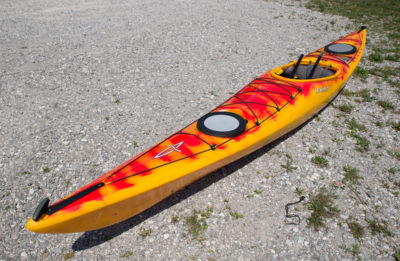

Personally, apart from the surfski case, I always favor the closed kayak, which allows you to navigate in any weather and in any condition, but also in this case, clearly, the intended use is very important. If I live in a warm place, I intend to use the kayak only in good weather, in quiet conditions, I do not intend to devote myself too much to acquiring the technique, then the sit on top may be a suitable choice. Conversely, if I intend to use the kayak even in winter, in adverse conditions, I intend to apply myself to acquire a good technique, then I will definitely choose a closed kayak.
Versione italiana
Continuiamo la serie di articoli rivolti ai neofiti per chiarire gli aspetti da considerare nell'acquisto della prima imbarcazione. Per chi se li fosse persi nel primo articolo abbiamo parlato di lunghezze e forme degli scafi, nel secondo abbiamo parlato dei vari materiali di costruzione e di come scegliere in base alle proprie necessità. In questo terzo articolo parleremo di canoe e kayak, sit in e sit on, per aiutare a capire quale sia più adatto alle nostre esigenze.
Iniziamo col fare un po' di chiarezza: tutte le piccole imbarcazioni con propulsione a pagaia, in cui cioè lo strumento di propulsione è svincolato dalla scafo e trattenuto solo dalle mani del conduttore, che deve quindi trasmettere la forza propulsiva allo scafo per il tramite del suo corpo, si chiamano canoe. Viceversa nelle barche a remi questi sono vincolati allo scafo tramite scalmi (o altri sistemi di connessione) e la forza propulsiva viene trasferita allo scafo attraverso questi punti di contatto.
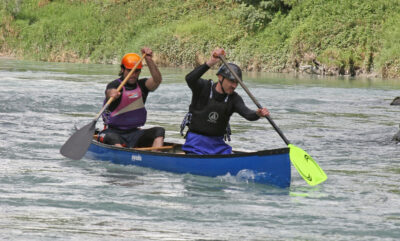
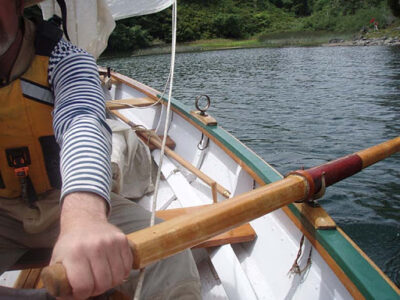
All'interno della vastissima categoria delle canoe possiamo fare una prima grande distinzione tra le canoe propriamente dette (canadesi, polinesiane ecc...), in cui si pagaia in posizione inginocchiata o seduta con un pagaia semplice, ossia dotata di una sola pala (o lama) e di una impugnatura a T dal lato opposto del manico, e i kayak in cui si pagaia, sempre seduti, con una pagaia doppia, ossia con due pale alle estremità opposte del manico. Sia le canoe che i kayak possono poi essere chiusi, cioè dotati di ponte con un abitacolo chiamato pozzetto, di dimensioni più o meno ampie, in cui il pagaiatore “entra” per condurre il mezzo (con la possibilità o meno di sigillare l'apertura con un paraspruzzi) o aperti, ossia non dotati di ponte.


Le canoe canadesi chiuse o pontate sono utilizzate quasi esclusivamente in ambito agonistico, e quindi non ce ne occuperemo in questa sede. Discorso simile vale per le canoe polinesiane dotate di bilanciere. Ci occuperemo invece delle canoe canadesi aperte (open canoe) che rappresentano uno dei più versatili mezzi per il turismo fluviale o lacustre. Non marino! Perché? Perché non essendo dotate di chiglia e offrendo più resistenza al vento rispetto ai kayak non sono adatte all'uso marino.
Sono state uno dei principali mezzi di esplorazione del continente nordamericano e ancora oggi sono un mezzo estremamente versatile. Sono diffuse soprattutto in versione biposto o multiposto, per uso familiare, ma vi sono anche modelli monoposto. I pregi di queste imbarcazioni sono la versatilità, la possibilità di caricare molto materiale, o compagni di escursione, ideali per chi vuole portare in gita il proprio cane, l'attrezzatura da campeggio ecc... L'ampio spazio aperto consente di muoversi (con accortezza) cambiare posizione, prendere il sole, fermarsi a fare uno spuntino senza dover sbarcare ecc... con la pratica si possono condurre anche in piedi, come un SUP. Rendendole inaffondabili tramite appositi palloni pieni d'aria possono essere utilizzate anche nelle rapide, ma è già un uso più specialistico. A livello di neofiti trovano il loro ambiente più adatto nei fiumi tranquilli di fondovalle o nei laghi, sono perfette per uso familiare, sia per gite brevi che di più giorni, in quanto permettono di portarsi dietro tutto l'occorrente. Per contro richiedono un apprendistato un po' più lungo per imparare a governarle, specialmente per il pagaiatore che sta seduto dietro, che deve occuparsi anche di tenere la direzione. Però un pagaiatore esperto può facilmente portare un completo neofita. Come abbiamo detto patiscono maggiormente il vento, a causa dell'altezza del bordo libero (bordi più bassi saranno meno sensibili al vento ma imbarcheranno più acqua in caso di onde). Mediamente, a parità di lunghezza e profilo, sono un po' più lente dei kayak, anche a causa della maggiore larghezza. Sono molto adatte per famiglie, campeggio, pesca, fotografia naturalistica, ecc...

I kayak hanno un profilo più basso sull'acqua per cui risentono meno del vento, possono essere più facili da governare (molto dipende dal modello e dal profilo, si veda il primo articolo), sono mediamente più veloci. Alcuni sono dotati di timone o appendici che rendono ancora più facile il controllo della direzione. La tecnica di base è un po' più facile da acquisire. Per contro hanno una capacità di carico molto inferiore, a parte rare eccezioni non è possibile portare animali o passeggeri, non è possibile (o molto poco) cambiare posizione e muoversi all'interno dello scafo.
Sono generalmente monoposto, più raramente biposto. Vi sono modelli specifici perfetti per uso marino.
Come si vede anche in questo caso, come scritto nel primo articolo, è indispensabile sapere prima quale sarà l'uso prevalente: se ad esempio voglio fare turismo marino dovrò orientarmi sul kayak, se invece voglio fare escursioni al lago con la famiglia o il cane sarà più opportuno scegliere una canadese.
Anche per i materiali, sia in caso di canoa che di kayak, vale quanto scritto nel precedente articolo.
Quando, a ragion veduta, la scelta ricada su un kayak, bisogna poi risolvere l'amletico dubbio: sit in o sit on? Sit in sono i classici kayak con pozzetto, in cui si “entra” e si può sigillare l'apertura con il paraspruzzi. Sit on top sono kayak in cui il pozzetto è sostituito da un'impronta più o meno anatomica, aperta, su cui ci si siede. Vediamo vantaggi e svantaggi di entrambi.
Un kayak sit in è più caldo e asciutto, si controlla meglio con le ginocchia permettendo di sfruttare maggiormente l'inclinazione, imparando la manovra dell'eskimo (la tecnica per raddrizzare lo scafo senza abbandonarlo) diventa molto sicuro e permette di affrontare acque molto mosse, può essere dotato di comportamenti stagni in cui riporre il materiale (chiamati gavoni). Per contro i novizi possono avvertire una sensazione di insicurezza legata al fatto di doversi “sfilare” dal pozzetto in caso di ribaltamento, se si è costretti ad uscire dallo scafo è più difficile (ma non impossibile) risalirvi dall'acqua, senza arrivare a riva.
Un kayak sit on top permette di prendere il sole anche sulla parte inferiore del corpo, offre al neofita una sensazione di maggior sicurezza in caso di ribaltamento, perché si è subito “fuori”. Sempre in caso di ribaltamento è più facile risalire dall'acqua. Se ben realizzato è praticamente inaffondabile. Per contro c'è generalmente meno spazio per stivare il materiale, ci si bagna di più, tranne poche eccezioni i modelli in commercio sono meno prestazionali e più pesanti dei sit in, eccezion fatta per i cosiddetti surfski, che però nascono come barche da competizione oceaniche e, anche se sono disponibili modelli più stabili e turistici, sono generalmente più adatti al fitness e alla pratica sportiva pura che al turismo nautico.


Personalmente, a parte il caso surfski, propendo sempre per il kayak chiuso, che permette di navigare con ogni tempo e in ogni condizione, ma anche in questo caso, chiaramente, molto conta l'uso che si intende fare. Se abito in un posto caldo, intendo usare il kayak solo nella buona stagione, in condizioni tranquille, non ho intenzione di dedicarmi più di tanto all'acquisizione della tecnica, allora il sit on top potrà essere una scelta indicata. Viceversa se intendo usare il kayak anche in inverno, in condizioni avverse, intendo applicarmi per acquisire una buona tecnica, allora mi orienterò senz'altro su un kayak chiuso.











 I kayak hanno un profilo più basso sull'acqua per cui risentono meno del vento, possono essere più facili da governare (molto dipende dal modello e dal profilo, si veda il primo articolo), sono mediamente più veloci. Alcuni sono dotati di timone o appendici che rendono ancora più facile il controllo della direzione. La tecnica di base è un po' più facile da acquisire. Per contro hanno una capacità di carico molto inferiore, a parte rare eccezioni non è possibile portare animali o passeggeri, non è possibile (o molto poco) cambiare posizione e muoversi all'interno dello scafo.
Sono generalmente monoposto, più raramente biposto. Vi sono modelli specifici perfetti per uso marino.
Come si vede anche in questo caso, come scritto nel primo articolo, è indispensabile sapere prima quale sarà l'uso prevalente: se ad esempio voglio fare turismo marino dovrò orientarmi sul kayak, se invece voglio fare escursioni al lago con la famiglia o il cane sarà più opportuno scegliere una canadese.
Anche per i materiali, sia in caso di canoa che di kayak, vale quanto scritto nel precedente articolo.
Quando, a ragion veduta, la scelta ricada su un kayak, bisogna poi risolvere l'amletico dubbio: sit in o sit on? Sit in sono i classici kayak con pozzetto, in cui si “entra” e si può sigillare l'apertura con il paraspruzzi. Sit on top sono kayak in cui il pozzetto è sostituito da un'impronta più o meno anatomica, aperta, su cui ci si siede. Vediamo vantaggi e svantaggi di entrambi.
Un kayak sit in è più caldo e asciutto, si controlla meglio con le ginocchia permettendo di sfruttare maggiormente l'inclinazione, imparando la manovra dell'eskimo (la tecnica per raddrizzare lo scafo senza abbandonarlo) diventa molto sicuro e permette di affrontare acque molto mosse, può essere dotato di comportamenti stagni in cui riporre il materiale (chiamati gavoni). Per contro i novizi possono avvertire una sensazione di insicurezza legata al fatto di doversi “sfilare” dal pozzetto in caso di ribaltamento, se si è costretti ad uscire dallo scafo è più difficile (ma non impossibile) risalirvi dall'acqua, senza arrivare a riva.
Un kayak sit on top permette di prendere il sole anche sulla parte inferiore del corpo, offre al neofita una sensazione di maggior sicurezza in caso di ribaltamento, perché si è subito “fuori”. Sempre in caso di ribaltamento è più facile risalire dall'acqua. Se ben realizzato è praticamente inaffondabile. Per contro c'è generalmente meno spazio per stivare il materiale, ci si bagna di più, tranne poche eccezioni i modelli in commercio sono meno prestazionali e più pesanti dei sit in, eccezion fatta per i cosiddetti surfski, che però nascono come barche da competizione oceaniche e, anche se sono disponibili modelli più stabili e turistici, sono generalmente più adatti al fitness e alla pratica sportiva pura che al turismo nautico.
I kayak hanno un profilo più basso sull'acqua per cui risentono meno del vento, possono essere più facili da governare (molto dipende dal modello e dal profilo, si veda il primo articolo), sono mediamente più veloci. Alcuni sono dotati di timone o appendici che rendono ancora più facile il controllo della direzione. La tecnica di base è un po' più facile da acquisire. Per contro hanno una capacità di carico molto inferiore, a parte rare eccezioni non è possibile portare animali o passeggeri, non è possibile (o molto poco) cambiare posizione e muoversi all'interno dello scafo.
Sono generalmente monoposto, più raramente biposto. Vi sono modelli specifici perfetti per uso marino.
Come si vede anche in questo caso, come scritto nel primo articolo, è indispensabile sapere prima quale sarà l'uso prevalente: se ad esempio voglio fare turismo marino dovrò orientarmi sul kayak, se invece voglio fare escursioni al lago con la famiglia o il cane sarà più opportuno scegliere una canadese.
Anche per i materiali, sia in caso di canoa che di kayak, vale quanto scritto nel precedente articolo.
Quando, a ragion veduta, la scelta ricada su un kayak, bisogna poi risolvere l'amletico dubbio: sit in o sit on? Sit in sono i classici kayak con pozzetto, in cui si “entra” e si può sigillare l'apertura con il paraspruzzi. Sit on top sono kayak in cui il pozzetto è sostituito da un'impronta più o meno anatomica, aperta, su cui ci si siede. Vediamo vantaggi e svantaggi di entrambi.
Un kayak sit in è più caldo e asciutto, si controlla meglio con le ginocchia permettendo di sfruttare maggiormente l'inclinazione, imparando la manovra dell'eskimo (la tecnica per raddrizzare lo scafo senza abbandonarlo) diventa molto sicuro e permette di affrontare acque molto mosse, può essere dotato di comportamenti stagni in cui riporre il materiale (chiamati gavoni). Per contro i novizi possono avvertire una sensazione di insicurezza legata al fatto di doversi “sfilare” dal pozzetto in caso di ribaltamento, se si è costretti ad uscire dallo scafo è più difficile (ma non impossibile) risalirvi dall'acqua, senza arrivare a riva.
Un kayak sit on top permette di prendere il sole anche sulla parte inferiore del corpo, offre al neofita una sensazione di maggior sicurezza in caso di ribaltamento, perché si è subito “fuori”. Sempre in caso di ribaltamento è più facile risalire dall'acqua. Se ben realizzato è praticamente inaffondabile. Per contro c'è generalmente meno spazio per stivare il materiale, ci si bagna di più, tranne poche eccezioni i modelli in commercio sono meno prestazionali e più pesanti dei sit in, eccezion fatta per i cosiddetti surfski, che però nascono come barche da competizione oceaniche e, anche se sono disponibili modelli più stabili e turistici, sono generalmente più adatti al fitness e alla pratica sportiva pura che al turismo nautico.

